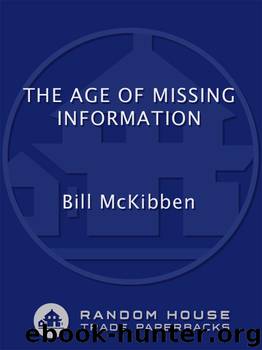The Age of Missing Information by Bill McKibben

Author:Bill McKibben [McKibben, Bill]
Language: eng
Format: epub
ISBN: 978-0-8041-5343-0
Publisher: Random House Publishing Group
Published: 2014-09-16T16:00:00+00:00
Dance Party U.S.A. is at the beach today. Jetskis careen through the waves; onshore it’s an hour of teenagers dancing nonstop to the hits of the moment. Almost all the boys are wearing jams and big breezy shirts; so are the few stout girls. The other girls are mostly in bikinis, or Lycra shorts, or something similar—the music never stops, and no one talks much. It’s just an endless roving camera shot of young bodies—of breasts quivering, and butts, and thighs. Except for a few obvious ringers none of the dancers are professionals; most of them, in fact, aren’t even very talented amateurs. As the hour wore on, a kind of trance seemed to settle over the action. In part, I think, this must have been due to the difficulty of strenuous dancing on loose sand. But the kids had, or so I imagined, a slightly baffled look, a what-am-I-doing-here? blankness in their eyes. Which is entirely appropriate, for in almost no other sphere have we managed to strip away meaning and information as thoroughly as in music and dance. Especially the music and dance that appears most often on television—the really popular stuff.
Music pounds from the television around the clock. Four networks—MTV, VH1, the Nashville network, and Country Music Television—devote themselves entirely to videos. And almost all this music and dance is popular—though the broadcast media began with classical music, it now has nearly vanished. I liked a lot of the hits everyone was playing—it’s what I’m used to, the sort of music I grew up hearing. But it is popular, that is, “of the people,” only in a peculiar and blanched fashion.
Music and dance, at their beginning and throughout most of their history, were drenched with content. On anthropological documentaries, they still are. Jamake Highwater, in a splendid show on the Discovery Channel, said that the Navajos danced to “make the sacred a visible part of life.” An Indian, rigged with feathers, danced the eagle dance—it was, says Highwater, “performed for pleasure, but was also a tribute to the bird that is the holy of holies.” Every traditional culture, writes Gary Snyder, “has its dance. The young people who come to the study of dance bring their perennial grace and power. They must learn to count the rhythm, memorize the plants, identify certain plants, observe the seasons, absorb the gestures of animals, and to move as timely as a falcon on a stoop. They thus are borne by their culture to become culture bearers.” Dance and music ordered time; they passed down the stories that bound civilizations together. As Oscar Brown, Jr., said on a program called Jumpstreet, “For Africans, dance is for functional reasons—to honor birth, to mourn death, to celebrate harvest.”
But by the end of the twentieth century, transposed to America, most of those functions have withered. The forms remain intact—Brown showed a sequence of grainy anthropological films of tribal dance intercut with Soul Train clips, and the resemblances were startling. But it wasn’t about God or harvest or community anymore—it was about you shaking your proverbial booty.
Download
This site does not store any files on its server. We only index and link to content provided by other sites. Please contact the content providers to delete copyright contents if any and email us, we'll remove relevant links or contents immediately.
Cecilia; Or, Memoirs of an Heiress — Volume 1 by Fanny Burney(32491)
Cecilia; Or, Memoirs of an Heiress — Volume 2 by Fanny Burney(31909)
Cecilia; Or, Memoirs of an Heiress — Volume 3 by Fanny Burney(31887)
The Great Music City by Andrea Baker(31752)
We're Going to Need More Wine by Gabrielle Union(18997)
All the Missing Girls by Megan Miranda(15760)
Pimp by Iceberg Slim(14433)
Bombshells: Glamour Girls of a Lifetime by Sullivan Steve(14019)
For the Love of Europe by Rick Steves(13493)
Talking to Strangers by Malcolm Gladwell(13284)
Norse Mythology by Gaiman Neil(13269)
Fifty Shades Freed by E L James(13184)
Mindhunter: Inside the FBI's Elite Serial Crime Unit by John E. Douglas & Mark Olshaker(9258)
Crazy Rich Asians by Kevin Kwan(9214)
The Lost Art of Listening by Michael P. Nichols(7451)
Enlightenment Now: The Case for Reason, Science, Humanism, and Progress by Steven Pinker(7270)
The Four Agreements by Don Miguel Ruiz(6693)
Bad Blood by John Carreyrou(6580)
Weapons of Math Destruction by Cathy O'Neil(6204)
